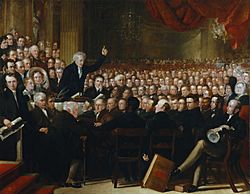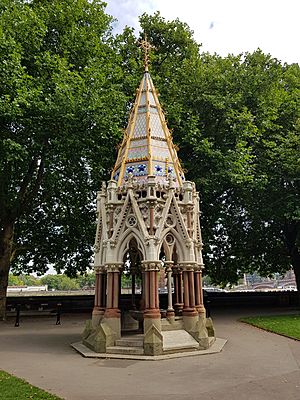Anti-Slavery International facts for kids
 |
|
| Abbreviation | Anti-Slavery |
|---|---|
| Founded | 1839 |
| Purpose | Anti-slavery |
| Headquarters | London, SW9 United Kingdom |
|
Region served
|
International |
|
Director
|
Jasmine O'Connor |
Anti-Slavery International is a group that works to end slavery around the world. It started in 1839 as the British and Foreign Anti-Slavery Society. It is based in the United Kingdom.
This group is the oldest international human rights organization. It focuses only on fighting slavery and other related unfair practices.
Over the years, the group's name changed several times. In 1909, it joined with the Aborigines' Protection Society. It became the Anti-Slavery Society in 1947. Later, it was known as the Anti-Slavery Society for the Protection of Human Rights. In 1995, it became Anti-Slavery International.
The group was inspired by an older organization that helped end slavery in the British Empire by 1838. The new Anti-Slavery Society was created to fight slavery in other countries.
Contents
History of Anti-Slavery International

Early Beginnings

Before Anti-Slavery International, other groups worked to stop slavery. One group, formed in 1787, helped end the international slave trade in 1807.
Another group, started in 1823, worked to end slavery in the British Empire. They largely succeeded by 1838.
Fighting Slavery Worldwide (1800s)
After slavery ended in the British Empire, people wanted to fight it everywhere. So, in 1839, the British and Foreign Anti-Slavery Society was formed. Its goal was to make slavery illegal in all countries.
Important people like Joseph Sturge helped create this new society. They organized the first World Anti-Slavery Convention in London in 1840. People from many countries, including the United States, came to this meeting.
A famous painting shows this important meeting. It hangs in the National Portrait Gallery in London.
During the 1850s, the society helped John Brown share his life story. This was before the American Civil War ended slavery in the United States.
Later, the Rev. Aaron Buzacott worked with Joseph Cooper. They researched and published works to help end slavery in places like the Middle East, Turkey, and Africa.
Campaigns in the 1900s
In the early 1900s, Anti-Slavery International fought against King Leopold II of Belgium and his cruel actions in the Congo Free State. This campaign was one of the first to use photographs to show the terrible abuses. These photos helped stop Leopold's harsh rule.
In 1909, the society joined with the Aborigines' Protection Society. They formed the Anti-Slavery and Aborigines' Protection Society. Kathleen Simon, Viscountess Simon was a key member of this group.
In the 1920s, the society helped end a system where workers were forced into labor in British colonies. They also stopped a company in Peru that used enslaved Indigenous people to make rubber.
The group also pushed for an investigation into slavery by the League of Nations. This led to the 1926 Slavery Convention, which made countries promise to end slavery. They also influenced the 1956 UN Supplementary Convention on the Abolition of Slavery.
From 1945 to the 1970s, the Anti-Slavery Society worked hard to end the slave trade in the Arabian Peninsula. They highlighted Saudi Arabia's role in slavery at the United Nations.
In 1962, Faisal of Saudi Arabia finally banned owning slaves in Saudi Arabia. Slavery was also abolished in Yemen in 1962, Dubai in 1963, and Oman in 1970.
In 1998, Anti-Slavery International helped organize the Global March against Child Labour. This march helped create a new international agreement in 1999 to stop the worst forms of child labor.
Fighting Modern Slavery (2000s)
Today, Anti-Slavery International continues to fight modern forms of slavery.
- In Nepal, they helped end a type of forced labor called Kamaiya.
- In Niger, their survey led to slavery becoming a crime in 2003.
- They pushed the Brazilian government to create a plan to end slavery.
- In 2005, they campaigned to rescue and return up to 3,000 child camel jockeys in the Gulf States.
In the UK, they helped make it a crime to traffic people for forced labor in 2004.
In 2008, they supported Hadijatou Mani, a former slave, in a court case. The court ruled that Niger had failed to protect her from slavery. This ruling set an important legal example.
In 2010, the UK Parliament made forced labor a criminal offense. The organization also showed how girls and young women were forced to work in clothing factories in India. This led to efforts to stop this practice.
Anti-Slavery International also pushed the UK government to sign an EU law against human trafficking. They also helped the International Labour Organization create a convention for fair work for domestic helpers in 2011.
In 2021, the group urged businesses and governments to address concerns about forced labor in the Xinjiang cotton industry.
About Anti-Slavery International
Anti-Slavery International is the world's oldest international human rights organization. Its work is based on United Nations agreements against slavery.
It works closely with other groups around the world to fight all types of slavery. It is an independent organization that is not linked to any religion or political party.
Anti-Slavery Award
Since 1991, Anti-Slavery International has given out the Anti-Slavery Award. This award highlights the ongoing problem of slavery. It also honors brave individuals and groups who campaign against slavery in affected countries.
- 1991: Bonded Labour Liberation Front (India)
- 1992: Ricardo Rezende
- 1994: Edwin Paraison
- 1995: Harry Wu
- 1996: Regional Indigenous Organisation of Atalaya (OIRA)
- 1997: Pureza Lopes Loiola
- 1998: Cheïkh Saad Bouh Kamara
- 1999: Vivek and Vidyullata Pandit
- 2000: George Omona
- 2001: Association for Community Development (ACD)
- 2002: Backward Society Education (BASE)
- 2003: Vera Lesko
- 2004: Timidria
- 2005: Cecilia Flores-Oebanda, (Visayan Forum Foundation)
- 2006: James Aguer Figueira
- 2007: Coalition of Immokalee Workers (CIW)
- 2009: SOS Esclaves
- 2010: Justice 4 Domestic Workers
- 2012: Temedt, a social movement in Mali
See also
- List of organizations that combat human trafficking
- Brazilian Anti-Slavery Society

